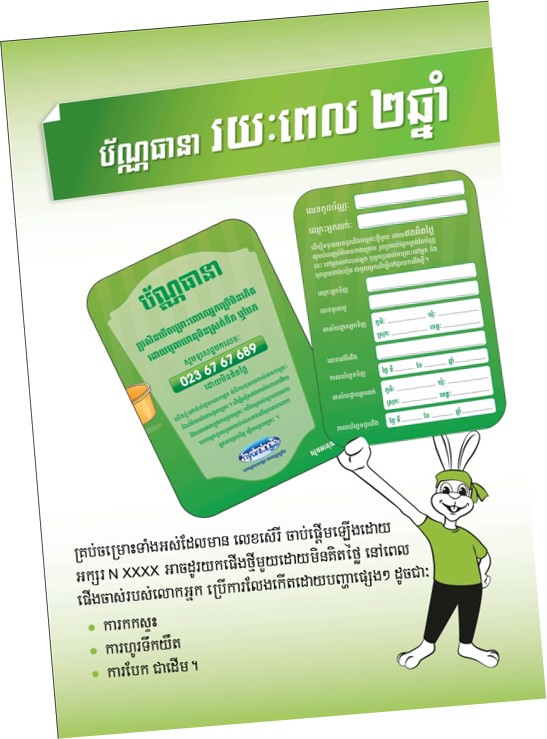This case study supports and illustrates the theoretic factsheet "After-sales" with practical insights.
During the development of Hydrologic from an NGO starting in 2001 to a viable social enterprise, various aspects have changed. Over time a thorough after-sales and warranty scheme has been introduced including customer satisfaction tracking. Today Hydrologic’s after-sales process focuses on developing and maintaining a proactive customer service.

Hydrologic, 2016
From the beginning of its operations in 2001, Hydrologic realised that various customers stopped using its locally produced Tunsai ceramic water filter. Investigations revealed that the main reasons for non-continuation were broken parts (ceramic filters and other parts). Accordingly Hydrologic introduced a 2-year warranty scheme. Each product comes with a warranty card as shown on the left, indicating purchase date to replace eventually broken parts within 2 years of purchase.
During this warranty time customers have the possibility to replace broken parts or the entire unit for free. To coordinate these customer problems or other complaints, a 24h-Hotline is offering assistance and coordinates repair and replacement services (see leaflet on the left side). These measures ensure a minimum filter lifespan of two years. It has also led to a much higher usage rate with over 72 percent of all sold filters still in use 2 years after the filter’s purchase. Additionally each sales area has at least two customer service officers. They were initially hired to mainly follow-up on complaints or technical issues, and replacing broken parts (for free) where necessary. To ensure more satisfied customers, the service officers have additionally been thoroughly trained on technical questions, maintenance and problem solving since 2015. Today these service officers are visiting first-time customers according to proper schedules within 4 to 6 weeks since the purchase to ensure they are happy with the product. During these follow-up visits any problems (usually regarding cleaning or maintenance) customers may be experiencing are tried to be solved. Service officers also provide spare parts that have been reported and asked for through the service hotline.

Ensuring existing customers are satisfied with the product and receiving prompt follow-up and support for any problem that occurs helped to build trust in the communities where Tunsai filters are sold. To thoroughly monitor customer satisfaction and sales data, a mobile data collection system for daily sales data tracking is in operation since 2016. Today the mobile data collection system is in use in all provinces (for another example see case study monitoring and evaluation on TARAlife). Hydrologic has also developed a customer service tracking reporting system that captures data on customer satisfaction – including overall satisfaction of customers and if applicable reason for complaints, time since purchase, resolution action and time taken to respond. This collected data helps additionally to improve sales strategy, marketing activities and training of salesforces.
- Hydrologic identified early on that a well performing after-sales team that is linked with the management team is one important aspect of satisfied customers and positive brand recognition. The feedback from customers can be transferred to the management and can be incorporated in sales and product strategy.
- The hotline provides a good product tracking and installation observation of the Tunsai filters in the field and helps identifying bottlenecks of the product and sales services as such, as well as close customer relations.
- The holistic after-sales system of Hydrologic allows to get back to customers by text, direct service or phone support and creates satisfied customers as they really feel taken care of, which they practically are also.
Hydrologic: Infiltrating the Market – Evolution of a Social Enterprise
Hydrologic has produced an extended case study documenting its 14 year evolution from a donor-funded NGO project to a sustainable social enterprise.
HYDROLOGIC (2015): Hydrologic: Infiltrating the Market – Evolution of a Social Enterprise. URL [Accessed: 31.05.2018]Going to Scale with Safe Water: Analyzing the Business Model of Hydrologic Social Enterprise in Cambodia
The thesis focuses on various aspects of Hydrologic’s innovative business model and the different elements and difficulties in relation to Cambodia’s water sector. The author identifies strategies to scale up the company in another country and provides helpful, praxis-oriented insights into the development, the needs, the challenges and potentials of the company in the scaling process.
KOHLER, S. (2016): Going to Scale with Safe Water: Analyzing the Business Model of Hydrologic Social Enterprise in Cambodia. St.Gallen: University of St.Gallen URL [Accessed: 18.04.2018] PDF

